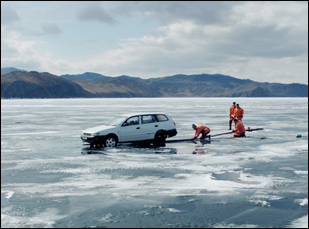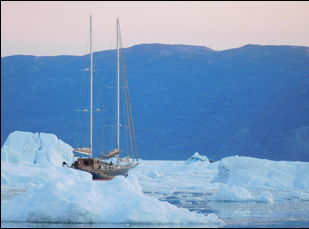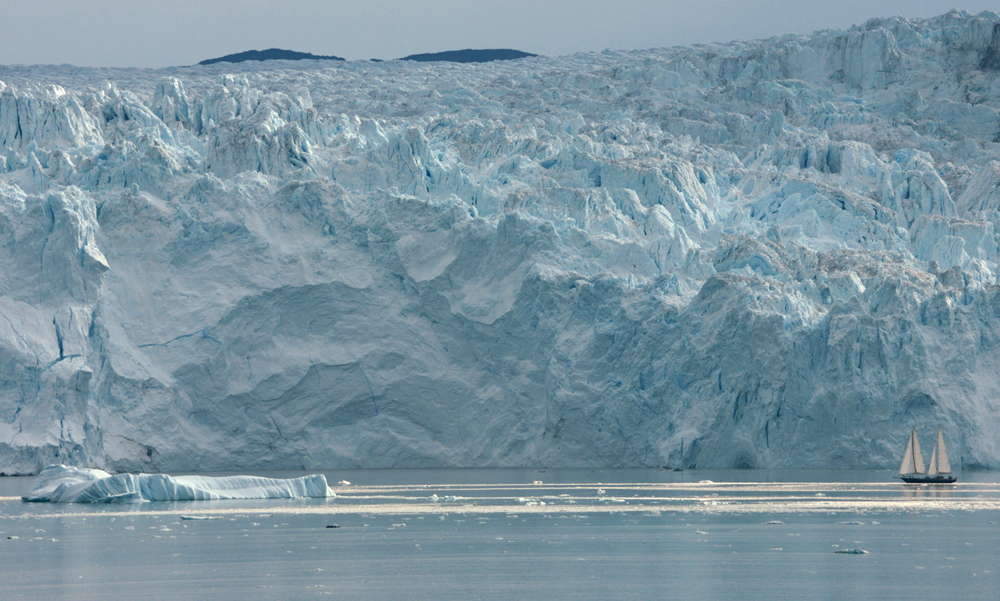It would be natural at first to think of “Aquarela” as an escape for much of the world’s population, taking audiences to the furthest reaches north when it first begins. In icy terrain largely unsullied by human touch, you are immediately hit with a blaze of white light in what appears as a tourist destination you couldn’t reach but for this camera recording it. However, the rumble of the earth reminds that indeed we’re all just tourists as the cracks and creaks of the ice can be heard just as piercingly as screams and by the time the walls of the glacier start to collapse and you see the ice floes drifting away, you realize how much history they carry with them, melting into the ocean as unceremoniously as humans could pass unnoticed into time.
This could feel like the ultimate defeat in the hands of another filmmaker, yet director Victor Kossakovsky’s eye-opening travelogue, filmed in the life-like 96 frame-per-second rate (and presented in most theaters in the still hyper-realistic 48) proves to be galvanizing, finding new ways to summon the unthinkable power of nature in order to better understand it and our own place in the ecosystem. Although “Aquarela” doesn’t adhere to an obvious narrative, offering little in the way of context as it moves from one area of the world to another to capture the grandeur of a waterfall or the devastation of a hurricane, it tells the story of a planet in rebellion, reasserting its awesome force at a time when there seems to be no human will to combat climate change.
Naturally to capture conditions increasingly inhospitable to human life, it was extraordinarily difficult for Kossakovsky to bring such an experience to the screen, traversing the same fragile terrain that threatens to swallow up the few humans he follows, whether it’s a sailor braving monster waves on the Atlantic Ocean or the handful of men on Lake Baikal in southern Siberia who tread lightly on the ice underneath that they’re hoping is strong enough to support them. Whether it can remains an open question that gives “Aquarela” extraordinary amounts of dramatic tension and becomes an extension of what the film asks about our reliance on nature as a whole, but in bearing witness to what damage has already been done, the film acts as a rousing call to arms, complete with a bitchin’ heavy metal score by Apocalyptica, to take steps to salvage what’s left by capturing the wonders of the world. With the film now hitting theaters, Kossakovsky spoke about how this unprecedented cinematic experience came about, how sound was every bit as important to capture as image and how the film changed him as a person and as a filmmaker.

Very accidentally actually. Someone called me and said, “Victor, we want to make a film about water. And I said, “No, no, no, no. I don’t want.” And they say, “Why don’t you want?” And I said, “I have seen 25 films in the past year about water and everybody talks about global warming, and we have to save water,” [all] talking heads — scientists, environmentalists, politicians, and I said, “One more film about talking heads, I refuse to do it.” Then one week later, they called me and said, “What if it’s called ‘Aquarela’ and you’re a painter and you have your camera as a brush and you have water as a paint — because if you translate it literally, it’s like watercolors — no talking heads.” So I said, “Yes, this I will do. If I don’t need to film scientists or politicians talking about problems, I will just show how water is in reality and use water as a character, a powerful character, beautiful and horrible at the same time, then I do it.”
I understand you did actually talk to scientists and other environmental experts beforehand, so did that give shape to how you wanted to approach this?
Yeah, this is what I normally do before I film. I really study. Probably I was a scientist in my previous life. [laughs] Or I will be a scientist in my next life. I’ve always been interested in the things we still don’t know, and the things we know aren’t interesting to me. For me, what’s interesting is when we cross the border and with water, there’s a lot we still don’t know. So I talk to scientists who have a lot of different opinions about this, I read books and I study everything – and then I put it in a corner and I take my camera and film my film, keeping in mind everything I heard. So I’m trying not to use my brain, but my intuition to express what I knew.
Did you have a strong idea about the places you wanted to film in advance?
No, I had some ideas, but after the first place we shot, [filming in Siberia] totally opened what I wanted to do. That is Lake Baikal [in the opening scene] and it became totally unpredictable in the first shooting day, so I realized I cannot follow the script, and what in the film is exactly the way it was filmed in chronological order. And then I said, “What can be filmed after this? It must be more powerful, more dramatic.” So I came to Greenland and I filmed this glacier and then I said, “Okay, what next?” And then I followed the icebergs and came to ocean, and then of course, I wanted to film huge waves and then a storm hit Miami, so it was one after another after another. It was totally intuition, and that’s why it’s a miracle because producers weren’t able to plan it ahead, so I did not tell them where I want to go next. They were able to follow me and trust me, so I would say this is like a first film when I say, “Wow, the producers were part of team, not like separate departments who are responsible for money.” They were really part of my crew.
Was it difficult to find equipment that could withstand all these different conditions?
This is one of the challenges. We spent a few months before to invent special gears and protections and special tricks for how we can make it in a way that there is no drop of water on the lens and the camera doesn’t move in a storm, also [to film at] 96 frames per second. We filmed many tests in 48, 60, 72, 96 and then 120 frames per second and when we saw it on the big screen, we said, “96 is best, most impressive image for water.” But it really was a few months of studying before we start.

No, actually this was a very old fashioned way [of recording]. I’ve worked with my sound man Alexander Dudarev since 1986 — it was my shooting day as a filmmaker and his first shooting day as a soundman. He’s so talented and he recorded a thousand small different types of sound for water and then we spent six months making a symphony from it. We even [thought] to make it without music because the sound itself was so rich, but we understood it’s so unusual that we probably need to help people a little bit because there is no narration and no story, and probably people are not used to watching such long films in poetic form, so in the end we came out with heavy metal music. But it was six months of [exploration] with sound and we came to the sound mix with 118 channels of sound all at the same time. 118 channels! It was absolutely impossible for any documentary. In documentary, you come to sound mix with six, eight, 12 tracks. And we came with 118 tracks? Can you imagine? It’s just absolutely insane. But [Alexander] is really a master and I’m privileged to work with such a person and generally, my team is just amazing.
How did you end up working with Apocalyptica on the score?
This was actually very easy. I just came to [Eicca Toppinen of Apocalyptica] and I explained [the film] to him and then he sent me a couple of minutes [of music]. Then I said, why don’t we do it differently. So I flew to him and said, “Listen man, I will not go from this room until you make [the score]. And it was like a tsunami — three days sitting in that room and for me, it’s a pity no one filmed that because it was really so inspirational. We were not eating, not sleeping, just doing it. And it was so amazing to work with him [because] he understood the music is not illustration. It was really a pleasure to work with such a person. And before I met him, [we had] a spending obligation in the UK [tied to certain production commitments], so I listened to 172 British composers and I met five of them in person and three of them made music for me. They were brilliant and they are super-famous — they do movies for Hollywood — but for this film, it didn’t work. It was not enough brutality. It was not enough of this crazy power. I [couldn’t] explain this brutal feeling, like ooh, something that goes through your bones. And then by luck when we saw a rough cut, everyone said, “Wow, it’s heavy metal.” And I said, “Yes, let’s take heavy metal.” And by luck, the Finnish band Apocalyptica had an English agent or producer, so it was possible to spend money in England, and a producer made it possible, but miraculously, [Eicca] was able to do it very fast with me.
Because you do make the force of nature the primary character, what did you want the presence of humans to be in the film?
In the beginning, I actually didn’t know it would be so empty [in terms of humans] because in the beginning, I [knew] my main character is the water, but of course I said, people will be around. But the more I filmed, the more it changed completely in my mind. I believe we think about ourselves too much. We believe we are the most important creatures in the world and the more I filmed, the more I understood I’m not sure we are really most important. Even the fact that we can only live without water for five days says a lot, right? And then the way we treat the planet as if everything for us and our comfort, [where] we do whatever we want, we spoil everything. We put garbage everywhere. We kill every other creature and plants and trees and animals and before this film, I’m not sure it’s correct, but after this film, I’m totally convinced it’s wrong. And we have to respect this world before we change it. We need to change ourselves, not the world.
You’ve said your next project is being told from the perspective of animals – has making this shifted your focus as a filmmaker?
Absolutely. I was always afraid to do any message film, but I guess it came to the point where you cannot just ignore what we are doing. It came to the point where we have to wake up a little bit and open our eyes and see who is around us and we have to face that we are not alone. There are creatures around who also have right to live and be here on this planet, so this film definitely changed me. There is no question. If I will not film, the rest of my free time I will fight for nature now. I probably still will not make activist film in the way people think of activist films — I will do that in my way. But the rest of my free time, I will dedicate to the planet now because we are doing something wrong.
“Aquarela” opens on August 16th in Los Angeles at the Arclight Hollywood and AMC Century City 15 and New York at the Landmark 57 West, the Angelika Film Center and the AMC Empire 25. A full list of theaters and dates is here.




